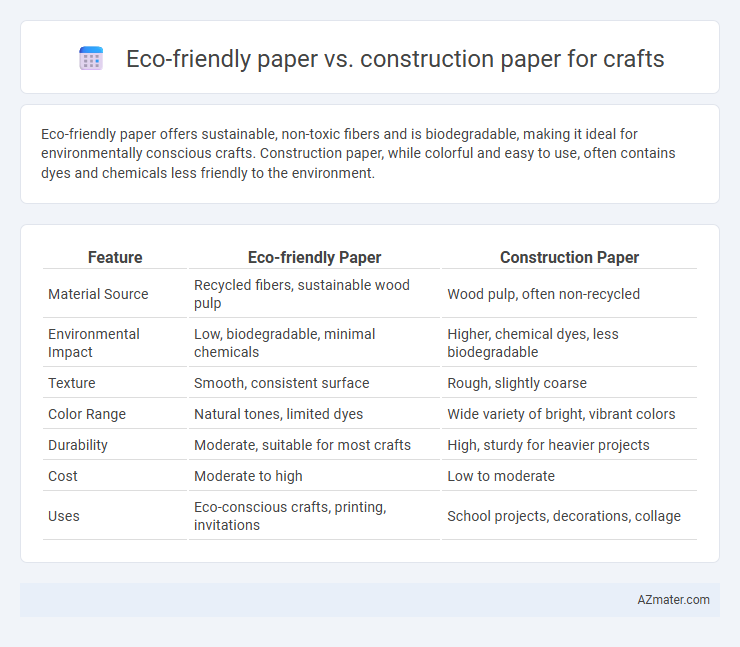Eco-friendly paper offers sustainable, non-toxic fibers and is biodegradable, making it ideal for environmentally conscious crafts. Construction paper, while colorful and easy to use, often contains dyes and chemicals less friendly to the environment.
Table of Comparison
| Feature | Eco-friendly Paper | Construction Paper |
|---|---|---|
| Material Source | Recycled fibers, sustainable wood pulp | Wood pulp, often non-recycled |
| Environmental Impact | Low, biodegradable, minimal chemicals | Higher, chemical dyes, less biodegradable |
| Texture | Smooth, consistent surface | Rough, slightly coarse |
| Color Range | Natural tones, limited dyes | Wide variety of bright, vibrant colors |
| Durability | Moderate, suitable for most crafts | High, sturdy for heavier projects |
| Cost | Moderate to high | Low to moderate |
| Uses | Eco-conscious crafts, printing, invitations | School projects, decorations, collage |
Introduction to Eco-Friendly and Construction Paper
Eco-friendly paper is made from recycled materials or sustainable sources, reducing environmental impact through lower resource consumption and chemical use. Construction paper, commonly used in crafts, consists of wood pulp with vibrant pigments but involves more intensive processing and less eco-conscious production. Choosing eco-friendly paper supports sustainable practices while offering similar versatility for everyday craft projects.
Defining Eco-Friendly Paper
Eco-friendly paper is produced using sustainable materials such as recycled fibers and non-toxic dyes, minimizing environmental impact through reduced water and energy consumption during manufacturing. This paper decomposes faster and avoids harmful chemicals, making it ideal for eco-conscious crafting projects compared to traditional construction paper, which often contains synthetic dyes and additives. Selecting eco-friendly paper supports sustainability goals while maintaining quality and versatility in craft applications.
What Is Construction Paper?
Construction paper is a type of heavy-weight, coarse paper designed primarily for arts and crafts projects, characterized by its vibrant colors and slightly rough texture that holds crayons, markers, and glue well. Unlike eco-friendly paper made from recycled fibers and sustainable sources, construction paper is often produced using virgin wood pulp and may contain dyes and chemicals that impact its environmental footprint. Its durability and bright pigmentation make it ideal for children's crafts and school projects, though eco-conscious crafters may seek recycled or FSC-certified alternatives to reduce ecological impact.
Environmental Impact Comparison
Eco-friendly paper significantly reduces environmental impact by using recycled fibers and sustainable sources, minimizing deforestation and lowering carbon footprints compared to traditional construction paper. Construction paper often involves chemical dyes and non-recycled materials, contributing to greater pollution and waste in landfills. Choosing eco-friendly paper supports resource conservation, waste reduction, and healthier ecosystems, making it a more sustainable option for crafting projects.
Material Composition and Sourcing
Eco-friendly paper for crafts is typically made from recycled fibers, alternative fibers such as hemp or bamboo, and often uses non-toxic, plant-based dyes, resulting in a sustainable and biodegradable material. Construction paper, on the other hand, is traditionally made from virgin wood pulp and may include synthetic dyes and coatings that can hinder recyclability and environmental impact. The sourcing of eco-friendly paper prioritizes renewable resources and ethical forestry practices, while construction paper relies more heavily on conventional pulp production with less emphasis on sustainability.
Durability and Craft Suitability
Eco-friendly paper offers moderate durability with a natural texture that enhances sustainable crafting projects, while construction paper provides higher durability and vibrant colors ideal for robust, colorful crafts and children's projects. Eco-friendly paper is better suited for artists prioritizing environmental impact and subtle, natural finishes, whereas construction paper excels in projects requiring sturdy material and bright pigmentation. Choosing between them depends on balancing durability needs with eco-conscious preferences for specific craft applications.
Color Vibrancy and Range
Eco-friendly paper exhibits a distinct advantage in color vibrancy, leveraging natural dyes that produce rich, deep hues while minimizing environmental impact. Construction paper offers a broader color range, with vivid and bright tones ideal for diverse craft projects, though it often contains synthetic pigments less sustainable for eco-conscious users. Selecting between eco-friendly paper and construction paper depends on balancing the desire for a vibrant, extensive palette against the priority of environmental sustainability in crafting materials.
Cost and Accessibility
Eco-friendly paper offers a sustainable alternative to traditional construction paper, often priced slightly higher due to environmentally responsible manufacturing processes. Construction paper remains widely accessible and affordable, making it a popular choice for bulk craft projects and educational settings. The balance between cost and eco-consciousness depends on project scale and budget constraints.
Best Uses for Each Paper Type
Eco-friendly paper excels in sustainable crafts, making it ideal for projects requiring recyclable or biodegradable materials, such as handmade cards or eco-conscious gift wrapping. Construction paper is preferred for vibrant, durable art activities like children's school projects and colorful collages due to its thick texture and bold color options. Choosing between these papers depends on the craft's environmental impact and the desired durability and color intensity.
Choosing the Right Paper for Sustainable Crafting
Eco-friendly paper, made from recycled materials or sustainable sources, offers a biodegradable and non-toxic option for environmentally conscious crafters compared to traditional construction paper, often produced with chemical dyes and less eco-friendly processes. Choosing eco-friendly paper supports reduced environmental impact by minimizing deforestation and pollution while maintaining durability and color vibrancy suitable for various craft projects. Prioritizing sustainable paper contributes to responsible crafting practices and promotes a greener, more sustainable art experience.

Infographic: Eco-friendly paper vs Construction paper for Craft
 azmater.com
azmater.com